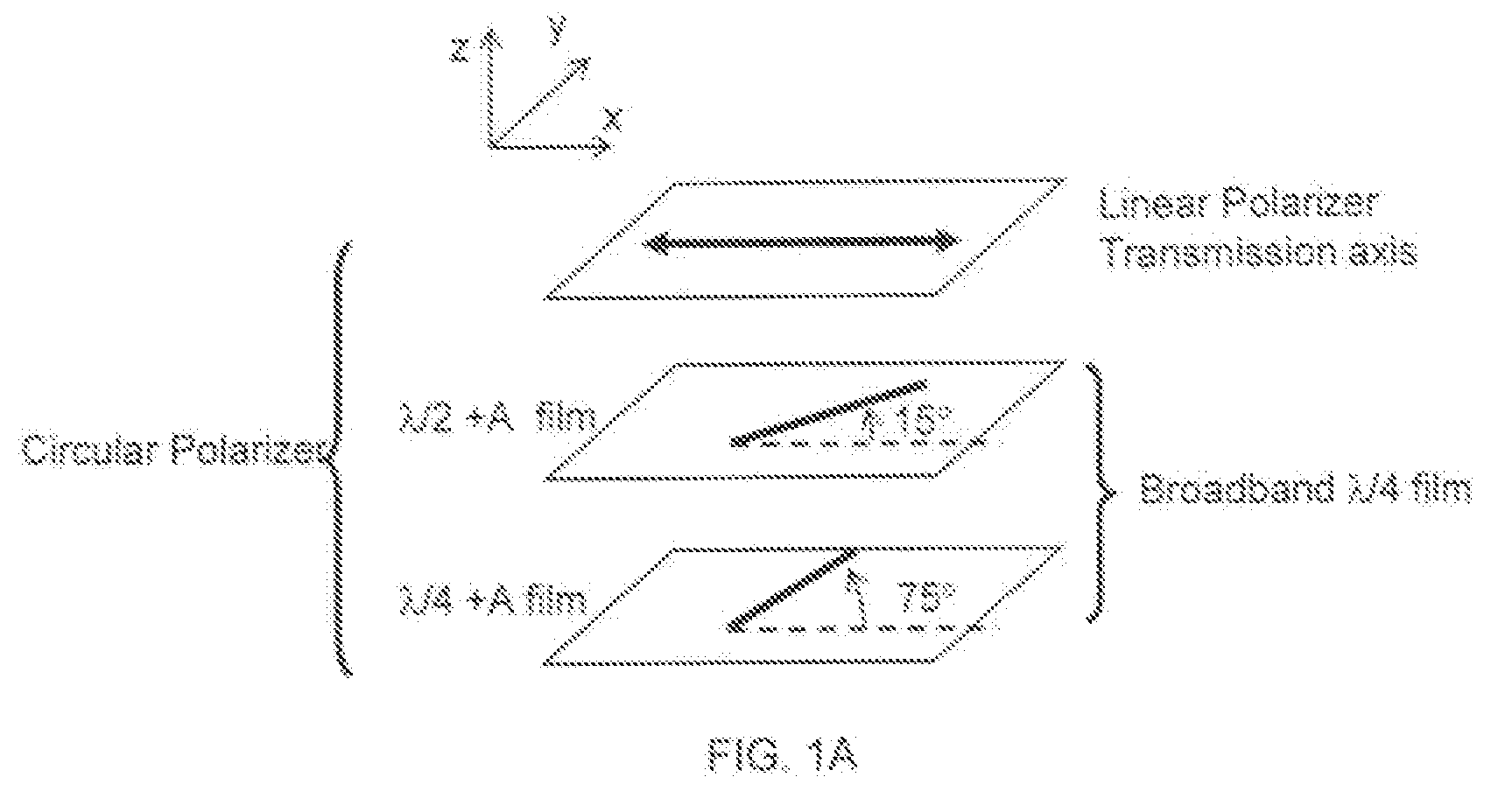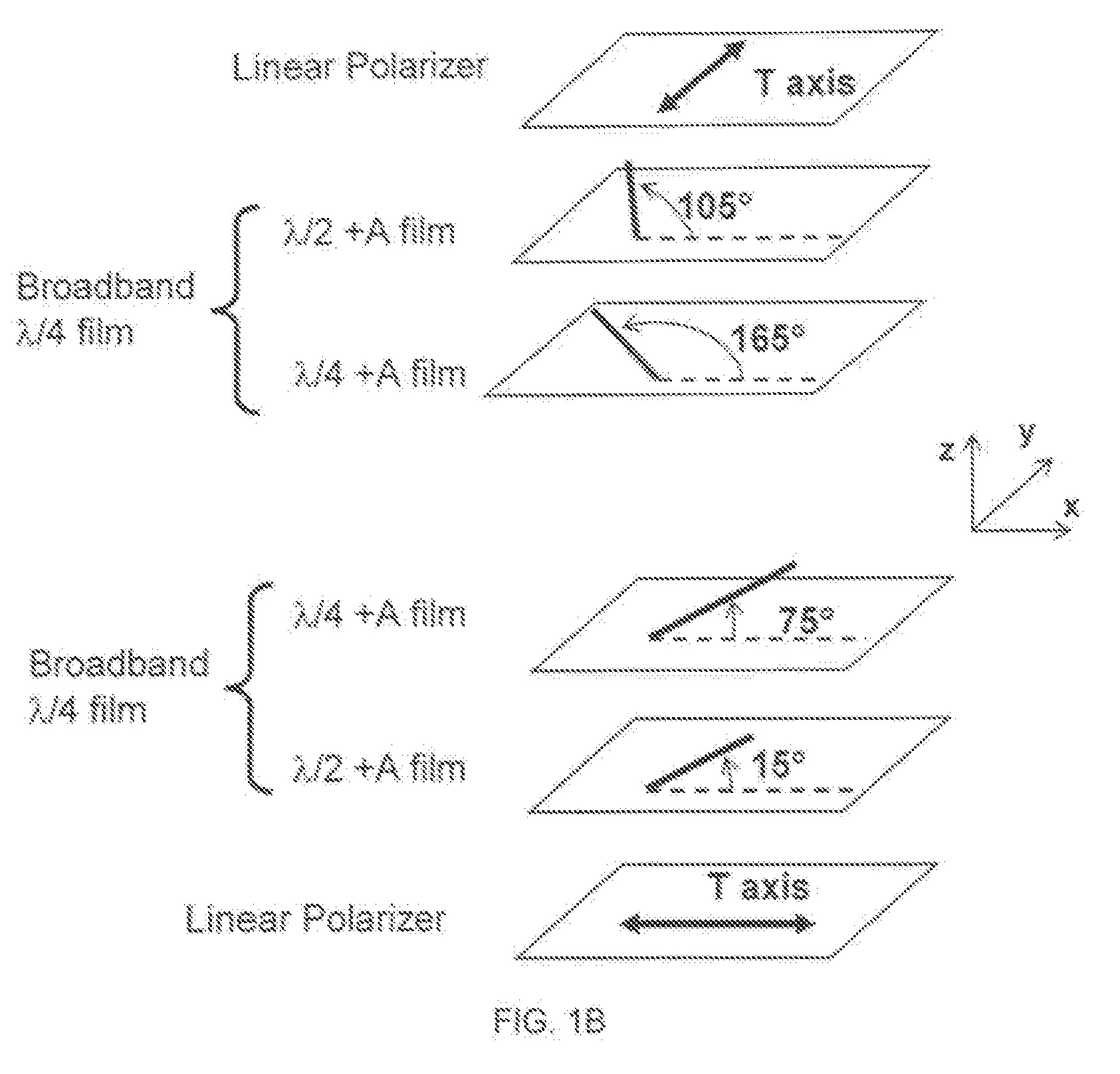Wide Viewing Angle and Broadband Circular Polarizers for Transflective Liquid Crystal Displays
a liquid crystal display and circular polarizer technology, applied in non-linear optics, instruments, optics, etc., can solve the problems of accumulation of off-axis phase retardation, poor viewing angle, poor viewing angle, etc., and achieve the effect of wide viewing angle and broadband performan
- Summary
- Abstract
- Description
- Claims
- Application Information
AI Technical Summary
Benefits of technology
Problems solved by technology
Method used
Image
Examples
embodiment 1
[0069]FIG. 3A is cross-sectional diagram of a first embodiment of the wide-view and broadband circular polarizer configuration in a transflective typed LCD or for the pure T typed LCD. A liquid crystal layer 150, such as a vertically aligned LC cell, is sandwiched between a first glass substrate 155a and a second glass substrate 155b, wherein a thin-film-transistor (TFT) array such as those shown and described in U.S. Pat. Nos. 5,528,055 to Komori; 6,424,396 to Kim et al.; and 6,760,087, each of which are incorporated by reference. A TFT transistor array can be formed on the bottom substrate 155a to provide driving voltages to modulate the liquid crystal layer therebetween.
[0070]The liquid crystal layer along with the two glass substrates are further interposed between two stacked broadband circular polarizers 130a and 130b, wherein these two circular polarizers compensate with each other to reduce the off-axis light leakage. The first circular polarizer 130a consists of a first lin...
embodiment 2
[0097]In a second embodiment of the present invention as shown in FIG. 9A, the birefringence of each A plate is just set opposite in correspondence to the configuration in FIG. 3A, wherein the LC cell 250 is sandwiched between a first glass substrate 255a and a second glass substrate 255b, wherein a thin-film-transistor (TFT) array (not shown here) is formed on the bottom substrate 255a to provide driving voltages to modulate the liquid crystal layer therebetween. The liquid crystal layer along with the two glass substrates are further interposed between two circular polarizers 230a and 230b. The first circular polarizer 230a further comprises of a first linear polarizer 200a, a first half-wave plate 210a, and a first quarter-wave plate 220a. The second circular polarizer 230b further comprises of a second linear polarizer 200b, a second half-wave plate 210b, and a second quarter-wave plate 220b. Their optic axis is shown in FIG. 9B.
[0098]As described in abovementioned Embodiment 1,...
embodiment 3
[0101]Yet in anther embodiment of the wide-view and broadband circular polarizer structure for a transflective typed LCD in FIG. 12A, the half-wave plate and the quarter-wave plate within each circular polarizer are of the same type (e.g., both are positive A plates, or both are negative plates), but corresponding half-wave plate or quarter-wave plate in different circular polarizers are of the opposite type. In FIG. 12A, a first linear polarizer 300a along with a first half-wave plate 310a and a first quarter-wave plate 320a forms the first broadband and wide-viewing angle circular polarizer 330a. Here both half-wave and quarter-wave plates in the first circular polarizer are made of positive A plates, wherein the transmission axis 301a of the linear polarizer 300a is set along the x-axis and the optic axes of the wave plates 310a and 320a are set at
ϕ+12λandϕ+14λ.
[0102]On the other side a second linear polarizer 300b along with a second half-wave plate 310b and a second quarter-wav...
PUM
 Login to View More
Login to View More Abstract
Description
Claims
Application Information
 Login to View More
Login to View More - R&D
- Intellectual Property
- Life Sciences
- Materials
- Tech Scout
- Unparalleled Data Quality
- Higher Quality Content
- 60% Fewer Hallucinations
Browse by: Latest US Patents, China's latest patents, Technical Efficacy Thesaurus, Application Domain, Technology Topic, Popular Technical Reports.
© 2025 PatSnap. All rights reserved.Legal|Privacy policy|Modern Slavery Act Transparency Statement|Sitemap|About US| Contact US: help@patsnap.com



